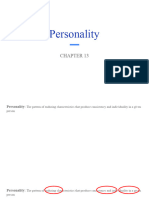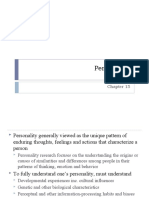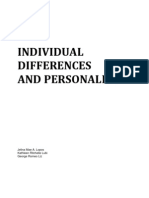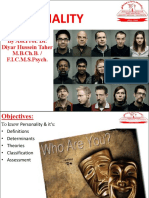0% found this document useful (0 votes)
29 views34 pagesPersonality
The document provides an overview of personality, its definitions, and various theories, including the psychodynamic approach founded by Freud, which emphasizes unconscious determinants and the structure of personality. It also discusses the contributions of Neo-Freudians, trait approaches, social cognitive perspectives, and biological influences on personality development. Additionally, it covers methods for assessing personality, such as interviews and self-report measures.
Uploaded by
Asra Laraib BhuttaCopyright
© © All Rights Reserved
We take content rights seriously. If you suspect this is your content, claim it here.
Available Formats
Download as PDF, TXT or read online on Scribd
0% found this document useful (0 votes)
29 views34 pagesPersonality
The document provides an overview of personality, its definitions, and various theories, including the psychodynamic approach founded by Freud, which emphasizes unconscious determinants and the structure of personality. It also discusses the contributions of Neo-Freudians, trait approaches, social cognitive perspectives, and biological influences on personality development. Additionally, it covers methods for assessing personality, such as interviews and self-report measures.
Uploaded by
Asra Laraib BhuttaCopyright
© © All Rights Reserved
We take content rights seriously. If you suspect this is your content, claim it here.
Available Formats
Download as PDF, TXT or read online on Scribd
/ 34























































































